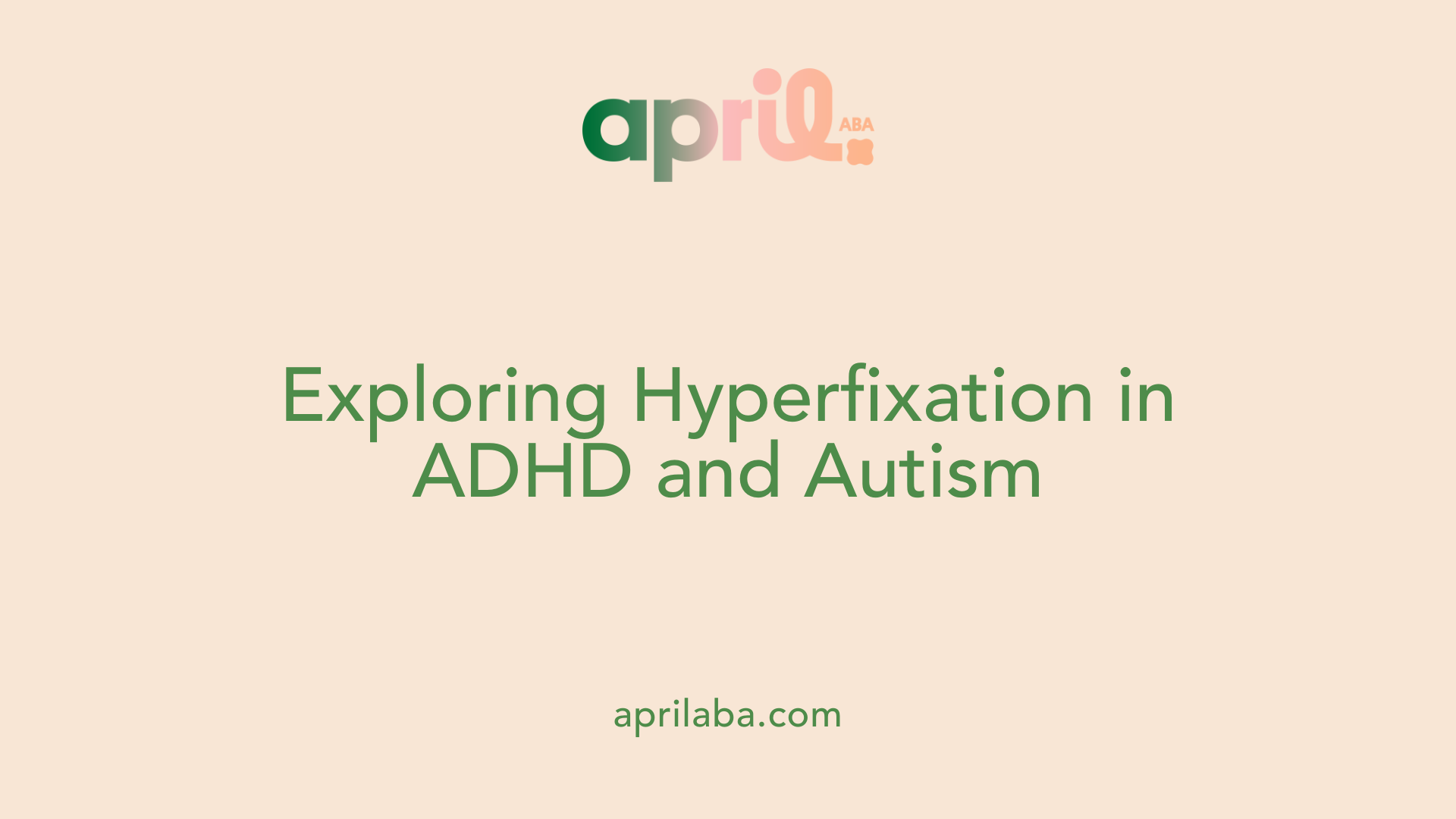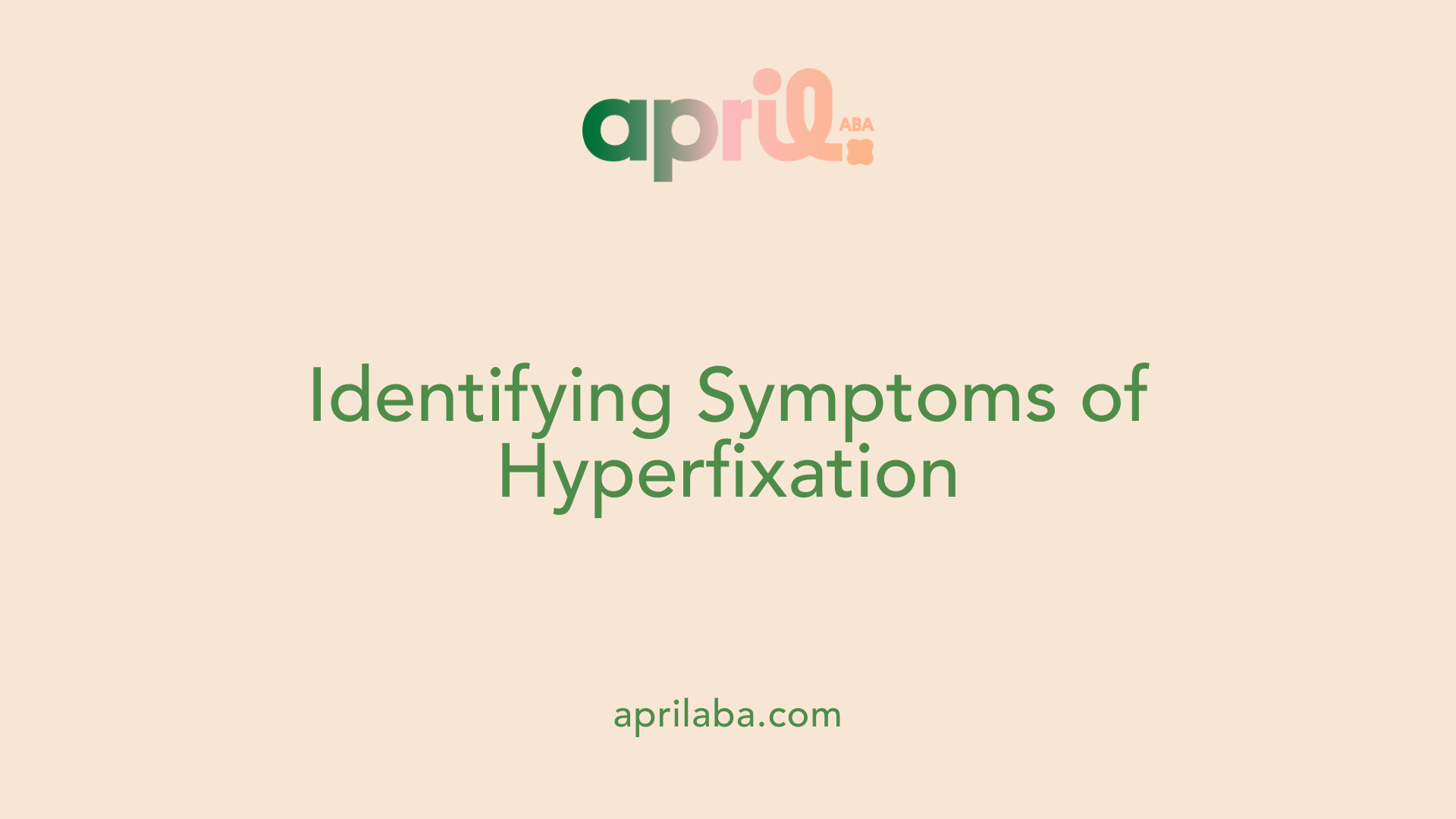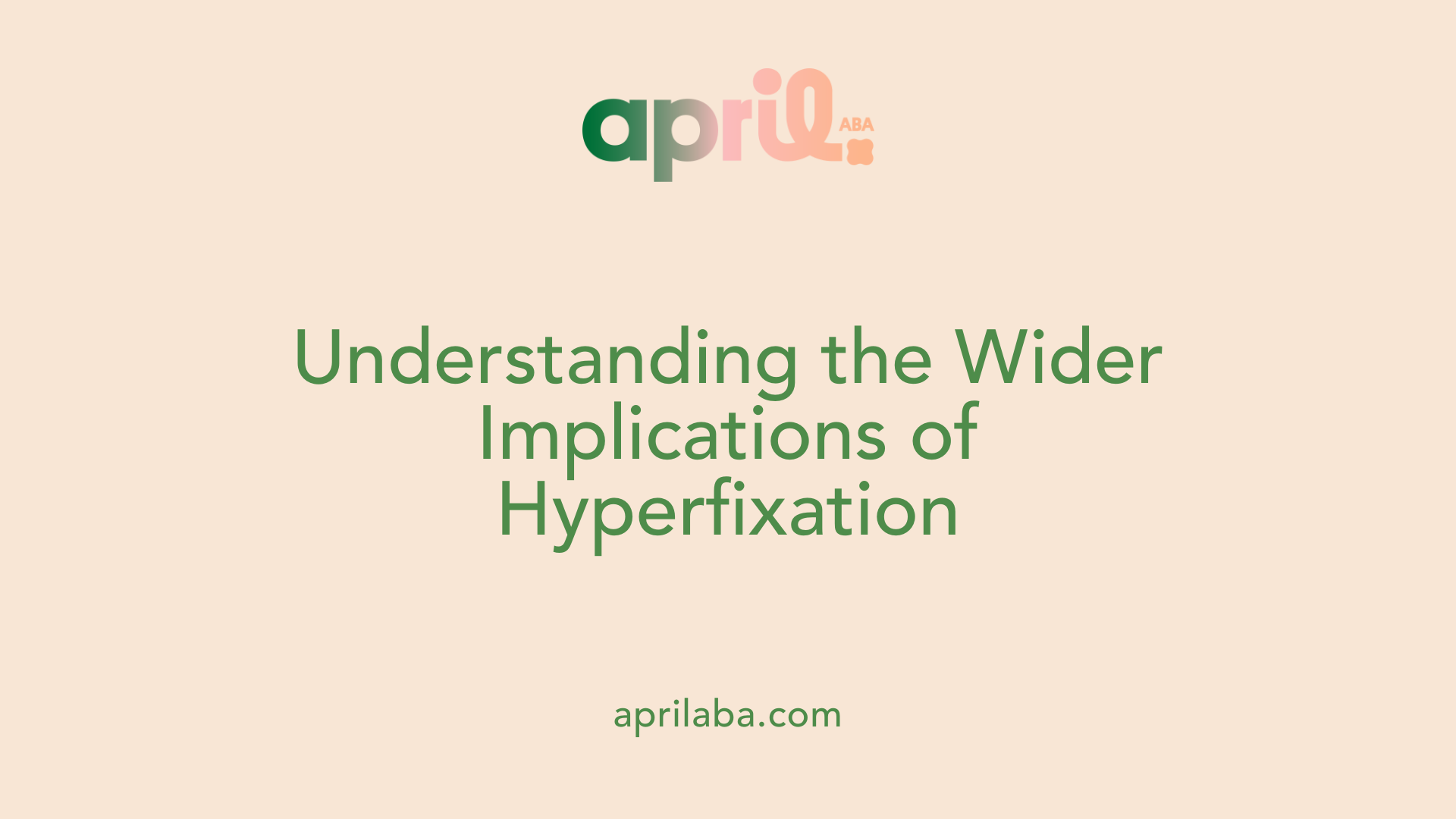What Is Hyperfixation
February 14, 2025
Understanding the Depths and Nuances of Hyperfixation


Introduction to Hyperfixation
Hyperfixation is a common experience in both neurodivergent and neurotypical individuals, marked by an intense focus on a specific person, activity, or object. It is particularly prevalent among those with neurodivergent conditions like ADHD and autism. This article aims to delve into the intricacies of hyperfixation, its causes, symptoms, and its impact on mental health and daily life, especially in adolescents. We will explore its relationship with ADHD, management strategies, and how it differs from similar concepts like hyperfocus and special interests.
Defining Hyperfixation

Understanding Hyperfixation
Hyperfixation is characterized by an intense and prolonged focus on a specific person, activity, or object, often leading to the exclusion of everything else in the individual’s life. This state can result in an almost trance-like engagement, where people may neglect their daily responsibilities, self-care, and social interactions. Common examples of hyperfixation include engrossing hobbies, detailed work projects, or even personal relationships, where the individual becomes so invested that they lose track of time and their surroundings.
Basics of Hyperfixation
Hyperfixation is particularly common among neurodivergent individuals, such as those with ADHD or autism, who may experience this phenomenon with heightened intensity. While hyperfixation is not an official symptom listed in diagnostic manuals, it is closely linked to how these individuals process rewards and manage attention. For example, a person might find themselves so captivated by a video game that they forget to eat or realize hours have passed while engrossed in a book.
The distinguishing feature of hyperfixation is its ability to boost performance in the focused task but also its potential to disrupt broader life activities. Overall, while hyperfixation can enrich experiences and deepen knowledge, it's essential to recognize when it leads to neglecting other vital aspects of life.
Occurrence Beyond ADHD
Can hyperfixation occur without ADHD?
Yes, hyperfixation can occur without ADHD. This intense and prolonged focus on a specific interest or activity is not exclusive to those with ADHD; it can manifest in both neurotypical and neurodivergent individuals. Often linked to conditions like anxiety, obsessive-compulsive disorder (OCD), and post-traumatic stress disorder (PTSD), hyperfixation can also arise in individuals who do not have any diagnosed mental health issues.
What are some associated conditions?
Many conditions and situations can foster hyperfixation:
- Anxiety Disorders: Individuals may focus on specific tasks or subjects to distract themselves from anxious thoughts.
- OCD: The nature of obsessions in OCD may lead to hyperfixation on particular worries or compulsions.
- PTSD: Traumatic experiences can trigger intense focus on specific activities or thoughts as a coping mechanism.
- Autism Spectrum Disorder: People with autism often develop hyperfixations on topics of special interest, which can enhance their knowledge and engagement but may also detract from daily responsibilities.
How does hyperfixation manifest?
In these contexts, hyperfixation can result in users spending significant time engrossed in their interests, potentially neglecting self-care and other responsibilities. The challenge lies in finding balance; effective management techniques such as professional counseling, mindfulness, and structured schedules can assist individuals in navigating hyperfixation in a healthier manner.
Hyperfixation's Link with ADHD and Autism

How does hyperfixation relate to ADHD and autism?
Hyperfixation is particularly notable among individuals with ADHD and autism, as these neurodivergent conditions often shape how people engage with their interests.
Individuals with ADHD may experience hyperfixation as a way to engage deeply with activities they find stimulating. This intense focus can lead them to immerse themselves in video games, hobbies, or academic subjects, often neglecting basic needs like eating or sleeping. The tendency to hyperfixate arises from underlying neurological factors like dopamine deficiencies, which contribute to a heightened response to rewarding experiences.
For those on the autism spectrum, hyperfixation manifests through special interests that dominate their attention and conversations. This engagement provides a sense of comfort and structure but can hinder social interactions if the focus becomes too consuming.
In summary, while hyperfocus is goal-directed, hyperfixation may lead to extensive, consuming interests that can disrupt everyday life—an experience common in ADHD and autism alike.
Recognizing Hyperfixation in Yourself

Symptoms and Self-Awareness
Hyperfixation can manifest through several distinct symptoms. Individuals may notice they lose track of time or become so engrossed in an activity that they neglect basic needs such as eating or sleeping. Feelings of detachment from the surrounding environment are also common, as one becomes entirely absorbed in the task at hand. This intense concentration may feel pleasurable at times, yet it can lead to negative consequences when important responsibilities or social interactions are disregarded.
Being self-aware is crucial in managing hyperfixation. Taking a step back periodically to evaluate how your focus affects your daily life and responsibilities can be beneficial. If you find yourself feeling irritable when interrupted or overwhelmed by the inability to switch tasks, these may be signs of hyperfixation.
Identifying Hyperfixation
To determine if you are hyperfixating, ask yourself the following questions:
- Are you intensely focused on an activity or interest that makes you ignore other obligations?
- Do you find it difficult to shift your attention from this task even when necessary?
- Have you lost track of time while engaged in this interest?
If you answered "yes" to these questions, it might be an indication of hyperfixation. Recognizing these patterns can be the first step towards employing effective management strategies, such as setting time limits for activities, allowing for breaks, and creating a balanced schedule to address other responsibilities.
Manifestations in Everyday Life
What are some examples of hyperfixation in daily life?
Hyperfixation can take many forms in the lives of individuals, especially those with ADHD. Some notable examples include:
- Video Games: Spending hours wrapped up in gameplay, often losing all track of time and neglecting other responsibilities, such as homework or chores.
- Books: Getting lost in a novel, reading it cover to cover without breaks. This kind of absorption can sometimes lead to an inability to stop even when there are pressing tasks that require attention.
- TV Shows: Binge-watching a favorite series, where episodes blend into one another, causing the viewer to forget about meals or social engagements.
- Hobbies: Immersing oneself in activities like painting, coding, or playing an instrument for extended periods, which can lead to increased skill but also to a lack of attention to essential daily needs.
- Collecting Knowledge: Delving into a specific subject and spending excessive time gathering information, which can enhance understanding but might lead to overlooking personal care or losing sleep.
Daily life impact
While hyperfixation can yield impressive skills or knowledge about specific interests, it also significantly impacts daily life. Some potential consequences include:
- Neglected Responsibilities: Individuals may overlook chores, work obligations, or even basic care like eating and sleeping.
- Social Disconnection: Intense concentration can lead to withdrawal from relationships, as maintaining social connections requires shifting attention that may not be possible during periods of hyperfixation.
- Time Management Issues: Task-switching becomes particularly daunting, leading to frustration and irritability when interruptions occur. This makes it challenging to balance engaging interests with necessary daily activities.
By recognizing hyperfixation and its multifaceted roles in life, individuals can better understand the balance between passion and responsibility.
Effectively Managing Hyperfixation

How can you manage hyperfixation effectively?
Managing hyperfixation effectively requires a multifaceted approach. A primary strategy is to set time limits on engaging in specific activities. This can establish a better balance between interests and daily responsibilities, preventing an all-consuming focus.
What is the role of mindfulness in managing hyperfixation?
Practicing mindfulness techniques is another key method. Mindfulness encourages individuals to stay present in the moment, which can reduce obsessive thoughts and help shift focus from the hyperfixated activity. Simple practices like deep breathing or brief meditative exercises can instill awareness and control.
How can support systems aid in managing hyperfixation?
Utilizing a support system made up of friends and family is crucial. Their encouragement and accountability can act as a buffer against prolonged hyperfixation, reminding individuals to engage in other areas of their lives.
When is it necessary to seek professional help?
For more persistent challenges, seeking professional support, such as through cognitive behavioral therapy (CBT), can provide tailored strategies and address any underlying emotional or psychological issues. This combination of personal strategies and professional guidance can lead to improved overall functioning and a healthier engagement with personal interests.
| Management Strategy | Description | Benefits |
|---|---|---|
| Setting Time Limits | Allocate specific time frames for activities | Balanced daily engagement |
| Mindfulness Techniques | Use practices to enhance presence and reduce obsessiveness | Better focus and emotional control |
| Support Systems | Involve friends/family for encouragement and accountability | Improved motivation and social ties |
| Professional Help | Seek therapy for personalized support | Targeted strategies for improvement |
Distinguishing Hyperfixation from Hyperfocus and Special Interests
What distinguishes hyperfixation from other similar concepts like hyperfocus and special interests?
Hyperfixation is often confused with hyperfocus and special interests, but each concept carries unique characteristics. Hyperfixation can be described as an intense and sometimes short-term obsession with a specific task, activity, or person. This absorption often leads individuals to neglect their responsibilities, including daily self-care tasks such as eating or sleeping.
In contrast, special interests represent long-lasting passions that can encompass various subjects or activities. These interests may enhance one's identity and influence career choices, typically allowing for a healthier management of focus alongside daily responsibilities. While both hyperfixation and special interests involve deep engagement, hyperfixation is more transient and can be detrimental to daily functioning when it interferes with essential life tasks.
How does hyperfocus compare to hyperfixation?
Hyperfocus is another critical concept related to hyperfixation, but it denotes an intense commitment to completing specific tasks without necessarily involving personal interest. It is often goal-oriented and can provide a 'flow state' where the individual feels energized and engaged in a task, even if it isn't inherently enjoyable. Unlike hyperfixation, hyperfocus does not always lead to neglecting responsibilities, as it tends to involve pursuing defined goals.
Individuals with ADHD and autism may frequently experience hyperfixation due to their unique neurological structures, causing them to process information differently. Neurotypical individuals can also encounter hyperfixation under specific circumstances, demonstrating that this behavior is broadly applicable beyond just neurodivergent conditions.
Overall, distinguishing hyperfixation from hyperfocus and special interests lies in the intensity and short-term nature of hyperfixation, along with its significant impact on daily life, in contrast to the sustained engagement found in special interests and the goal-directed nature of hyperfocus.
| Concept | Definition | Impact on Daily Life |
|---|---|---|
| Hyperfixation | Intense absorption in a specific interest or activity | Often neglects responsibilities |
| Hyperfocus | Goal-oriented engagement in a task | Less likely to neglect self-care |
| Special Interests | Long-lasting passions that may influence identity and activities | Balances interest with daily life |
Adolescents and Hyperfixation: A Complex Relationship
Can hyperfixation impact adolescents differently?
Yes, hyperfixation can impact adolescents differently based on various underlying conditions such as ADHD, anxiety, OCD, autism, and depression. For example:
- ADHD: Teens with ADHD may hyperfocus on enjoyable activities, like video games or hobbies, which can lead to significant neglect of responsibilities like schoolwork and chores.
- Autism: Adolescents with autism often fixate on specific subjects due to emotional attachments, allowing them to dive deeply into their interests. This may provide them with comfort in times of stress.
- Anxiety and Depression: Intense focus can serve as a coping mechanism, enabling depressed or anxious teens to temporarily escape overwhelming feelings.
While hyperfixation can lead to productive engagement in activities, it can also result in negative outcomes. For instance, social isolation may increase when a teen becomes overly focused on an interest at the expense of relationships. Moreover, neglecting essential self-care practices—like eating, sleeping, and hygiene—can negatively impact overall well-being.
Impact on teens
The effects of hyperfixation on adolescents' mental health are substantial. It can lead to:
- Stress from neglecting responsibilities: As students focus intensely on a particular activity, academic performance may suffer.
- Difficulty in social interactions: Withdrawal from social opportunities due to absorption in interests can lead to feelings of loneliness.
- Management challenges: Understanding the context and manifestation of hyperfixation is essential for addressing its impact on adolescent mental health and ensuring healthy coping strategies are in place.
The Broader Impacts of Hyperfixation

Daily Life Consequences
Hyperfixation can significantly disrupt daily routines and responsibilities. Individuals often lose track of time, becoming so engrossed in their focus that essential needs—such as eating, sleeping, or attending to work—are neglected. This intense concentration can lead to difficulties in managing time effectively, often resulting in missed deadlines or incomplete tasks.
Additionally, hyperfixation may cause individuals to overlook important obligations or personal care, leading to negative consequences in both professional and academic settings. The inability to switch attention can strain productivity and hinder overall well-being, ultimately affecting one's lifestyle.
Social and Personal Effects
Social relationships often take a hit when hyperfixation occurs. Individuals may become so absorbed in their interests that they ignore friends and family, causing feelings of isolation. This detachment can lead to misunderstandings or frustrations among peers, who might find it challenging to engage with those consumed by their hyperfocus.
Moreover, the psychological impacts of hyperfixation can include guilt or frustration upon realization of neglected responsibilities and relationships. While some may find joy in their intense focus, they might also experience emotional turbulence if they feel they have drifted away from loved ones. Thus, while hyperfixation might foster deep engagement in a subject, it is crucial to remain aware of its broader implications for personal and social dynamics.
Concluding Thoughts
In conclusion, hyperfixation is a multifaceted phenomenon that varies widely in experience across individuals, particularly those with ADHD and autism. Understanding the subtle differences between hyperfixation, hyperfocus, and special interests helps in appropriately addressing the challenges it may pose. With effective management strategies and awareness of its impact on daily life and mental health, particularly in teens, individuals can harness the positive aspects while mitigating the negatives. This understanding opens pathways for better self-care and personal growth, ultimately supporting a balanced lifestyle.
References
- ADHD & Hyperfixation: The Phenomenon of Extreme Focus
- Hyperfixation: What It Is & How To Combat Hyperfocusing
- Hyperfixation Definition and Meaning - Top Hat
- Special Interest vs. Hyperfixation: Differences and Resources
- Hyperfixation: What Parents of Teens Need To Know
- Hyperfixation and depression: Is there a link? - MedicalNewsToday
- What is hyperfixation? Symptoms, causes, and how it can be managed
- What Is ADHD Hyperfixation? Facts From a Mental Health Expert
- What Is Hyperfixation, and Does ADHD Cause It? - Frida
Join Our
Community
At April ABA, we're committed to providing you with the most up-to-date, relevant, and helpful resources to support your family's autism journey. Be sure to check back often, as we continuously add new content to keep you informed and empowered.
.webp)

.svg)
.svg)
.svg)
.svg)




.svg)

.svg)